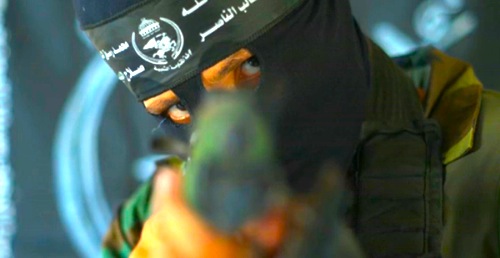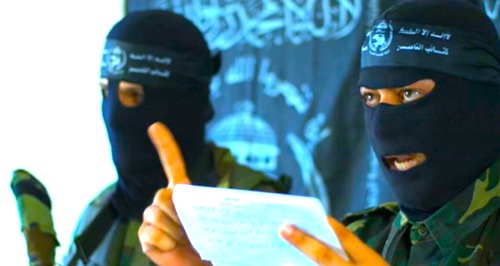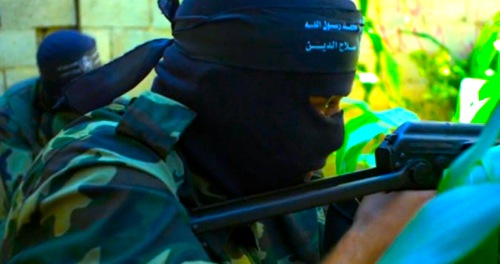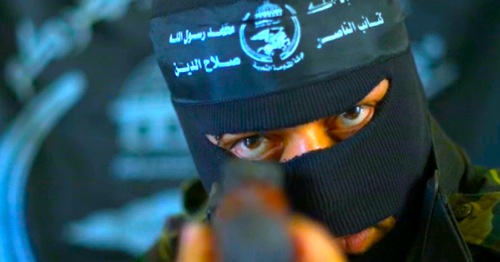[Editor’s Note: Recently I came across this striking video above, by New York-based filmmaker Richard Mosse. At first glance, I was shocked by what appeared to be a shahid-style terror video made by a Western filmmaker. Watching the video through, however, it occurred to me that this likely was not an actual terror video, so much as a kind of ‘genre’ piece or riff on terror videos. My thoughts then moved to the question of what an expert in this area might think of it. Fortunately I was able to turn to LFM Contributer ‘Max Garuda,’ who works in the field and has access to Arabic translation.]
“A short terror video made in Gaza. Possibly the only such video ever made by non-Palestinian producers. As a result, the representation breaks with the conventions of the Palestinian suicide video genre. In Arabic, ‘shahid’ means martyr, or witness.” – Filmmaker/photographer Richard Mosse, describing his video Shahid.
By ‘Max Garuda‘. The artist’s commentary above alerts the viewer to the existence of a ‘terrorist video genre,’ and that Mosse’s creation breaks with that category. This assertion raises two questions: what is the ‘terrorist video genre’ and what conventions does Mosse’s video contest? (An argument can be made that any film belongs in any genre if anyone can make a compelling argument for inclusion. Or, said differently, film/video genres are not fixed sets of criteria by which categorizations are easily made. Rather, they are fluid, evolving bodies of work, responding to artistic practice, distribution/marketing strategies and audience expectations.)
That being said, why does Mosse desire to characterize his video within the ‘terrorist video genre’ or by comparison to it – especially when the differences that do exist are so significant enough to make a strong argument that his video doesn’t break from the genre, but rather has nothing to do with the genre. But first, a little background on the ‘terrorist video genre.’

As the title might suggest, the most obvious distinguishing characteristic of the genre was originally the provenence of the video followed by content. Generally speaking, only terrorists made ‘terrorist videos,’ which were used to showcase the terrorizing act or transmit a message requiring some expression of authenticity. The terrorist act depends on shock and a visceral reaction by the ‘public’ of the terrorized. A beheading that occurs in the forest is just a beheading; a beheading captured on video and spread globally by broadcast news or the Internet is an act of terror. Videos showing murders, explosions and other deadly acts were created to broaden the impact of the terrorist act. The ‘theater of terror’ is a common framework for understanding terrorism, in which the terrorist’s act must have the paralyzing effect of fear – because the scope of the actual violence is quite limited. Even the 9/11 attacks, with their relatively high death toll, depend on the ‘theater of terror’ effect for their power–changing how Americans (and other countries and their citizens) conduct their daily lives, from intrusive security measures to a simple constant state of fear. Many early terrorist videos operated in this domain.
The other common example of early terrorist videos were simply video-based messages. Whether VHS tapes smuggled out of remote bivouacs to eager news outlets or digital videos posted to websites, the form of the terrorist video was targeted primarily at followers of the movement, to ensure them that the leadership was still alive and in control. Hence, the periodic release of a video of Osama bin Laden exhorting his followers or Ayman al-Zawahiri expounding on a facet of Islamic exegesis that fits his extremist goals. The target of these videos was generally the faithful, and secondly the ‘contested populations’ or those that don’t openly support the extremists but aren’t too convinced of the piety, competence and forthrightness of local government.

More recently, though, we see a fusion of these two goals (theater of terror and strategic messaging) into the genre of the ‘terrorist video’ that Mosse and his collaborators purport to produce. In this newer class of terrorist videos, we usually see direct address of the camera by the producing group, images of their heroes (Bin Laden, Al-Zarqawi, etc.), and sometimes images of their terrorist acts or types of acts the video implies are imminent. Because these newer videos are not as gruesome as the beheading type video, and because they are frequently hagiographic in their treatment of extremist heroes and martyrs, their access to the ‘theater of terror’ is less about instilling fear in a subject population, but rather in making a spectacle of the process of terrorism and thus improve recruitment within the contested population (particularly disaffected youth).
Taking a look at a good example of the new terrorist video, such as the video called “Al-Shahada” (found here), we see some of the common traits of the terrorist genre. Images of the heavens, rendered through video effects easily available through many laptop video editing applicatons, are accompanied by a soundtrack of Qur’anic verse. Transition effects then isolate young fighters, suicide bombers and more well-established heroes (such as Zarqawi, here). Natural beauty stands in for the heavens, superimpositions over eyes and beating hearts indicate oneness with Allah, again all of these effects rendered through prosumer level effects suites. This is above average filmmaking for amateurs, and this modest level of production value translates as part of the authenticity of the videos themselves. The still images and video footage contained within have clearly been shot with consumer grade cameras, the kind widely available throughout many parts of the world – the kind easily carried without bulky support equipment.

For some time now, in part because of the widespread availability of consumer grade cameras and especially because of the proliferation of mobile phones producing grainy still and moving images, degraded image quality has accrued an association with authenticity. Camera phones are ubiquitous, and thus have the capacity to provide ‘first on the scene’ reporting and footage. Think of the first images of the Indonesian tsunami of 2004. Tourist video and camera phone images ran day and night on CNN, BBC, and the like. CNN frequently preferred grainy cellphone and handheld video in the early days of the second Iraq War to showcase their ’embedded’ journalists and the contrast with the sterile press room footage of the 1991 conflict.
It is in this issue of image resolution and authenticity that questions arise about Mosse’s video, his production choices and his artistic intent. The hyperclear HD footage of Mosse’s video stands in stark contrast to the consumer grade footage that marks the terrorist video genre from its early days of VHS to today’s recruitment montages. Secondly, there is a sterility and a stillness to Mosse’s video, whereas the Al-Shahada video and others like it contain plenty of extraneous activity–muffled conversations in the background, street noise, people moving about. This contrast heightens the staged nature of Mosse’s video. The performance of the lead actor (and in my opinion he is an actor, hired to play a role) lacks the raw emotion commonly seen in newer terrorist videos when the terrorist directly address the camera, nor does this performance carry the gravitas and authority of a major terrorist leader. (I asked a colleague who speaks Arabic for his opinion, and he thought something was off in the actor’s Arabic–likely not a native speaker and very possibly an American accent to the Arabic).

So, in the end, I’m at a bit of a loss: Mosse’s video doesn’t conform to the current trends of the terrorist genre enough to claim a ‘break’ from that genre. It lacks hagiographic treatment of fellow extremists, it lacks videographic representations of paradise and Allah, and it lacks the authenticity of setting and production value. It also lacks the mash-up and remix aesthetic that has become common place in the genre, in which brief excerpts from Western films are intercut into a terrorist video. In fact, the terrorist video genre has become quite Hollywoodized with clear narrative structure, prolific use of effects, and incorporation of Hollywood scenes.
If the captions and comments on the video’s page are taken at face value, then Mosse went to Gaza to produce a ‘terrorist video’ with a non-Palestinian crew. That may very well be true. But it ends up looking like a staged shoot, showcasing a fancy camera – one that could have been shot in New Jersey or California, or 1000 other places. That leaves us with the title, “Shahid”, reported as ‘martyr’ or ‘witness’. While I’m impressed with the camera work and the attempts to exploit the clarity of the HD, after all is said and done that is what I’m left witnessing: a filmmaker’s use of a tool, dabbling with a topic of interest. Perhaps what I perceive as the contrived nature of this video is precisely the point– a commentary on the contrived logic and appeal of suicide bombing in general. I doubt it, but the contrasts with the genre are so stark, and Mosse’s other work (especially his photographs) are sufficiently compelling, one has to think the deviations were not unintentional. Some might say any artist has done his job if he forces us to think, and at least in that regard this video is successful.
Posted on September 1st, 2010 at 12:07pm.
Very interesting piece, Max. I think this is the first time I have ever seen a conservative website – or any kind of film website – ever seriously analyze terrorist videos (or a pseudo-terrorist video) like this one. It’s a difficult and unpleasant subject, but it’s important to understand how the terrorists operate and use film and video themselves to get their message across. We talk all the time about how Hollywood slips left-wing propaganda into its films, and yet we never discuss how the terrorists overseas use film/video technology for their own propaganda. If we want to stop these people, we really have to look seriously at the subject of propaganda and how it’s used to recruit more terrorists, and you do that in a very interesting manner in this essay – especially with bringing up the concept of “the theater of terror.”
Bravo for a truly thoughtful and original piece.
Thanks, Trojan. I will convey your message to ‘Max,’ whose current whereabouts are shrouded in mystery …
Max – how does the whole “terrorist video” genre play into the prohibition against images in Islam? If these people are such religious “true believer” fundamentalists who claim that they want to enforce a literal interpretation of Islam on everyone, then how come they can get away with filming each other like this? Isn’t that against the Koran? Or maybe they’re just hypocrites who don’t even follow the Koran the way they say they do, and are just angry thugs who pursue violence for its own ends and use religion as an excuse.